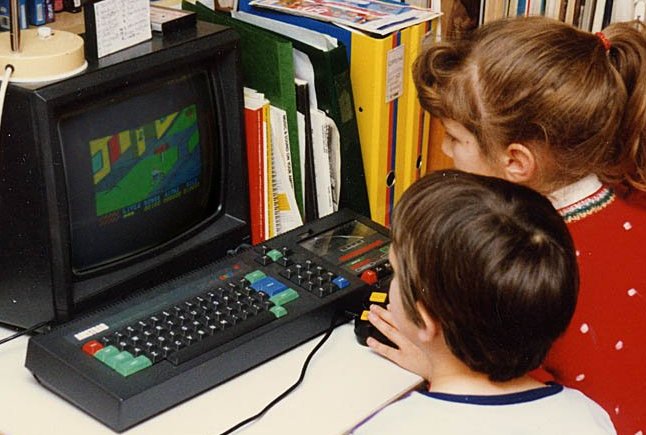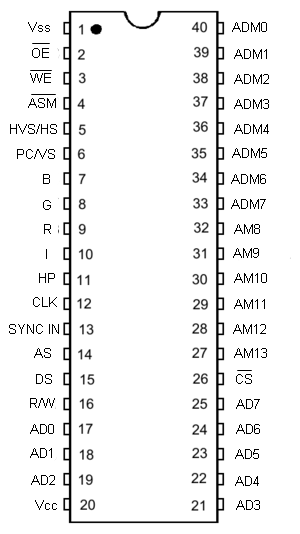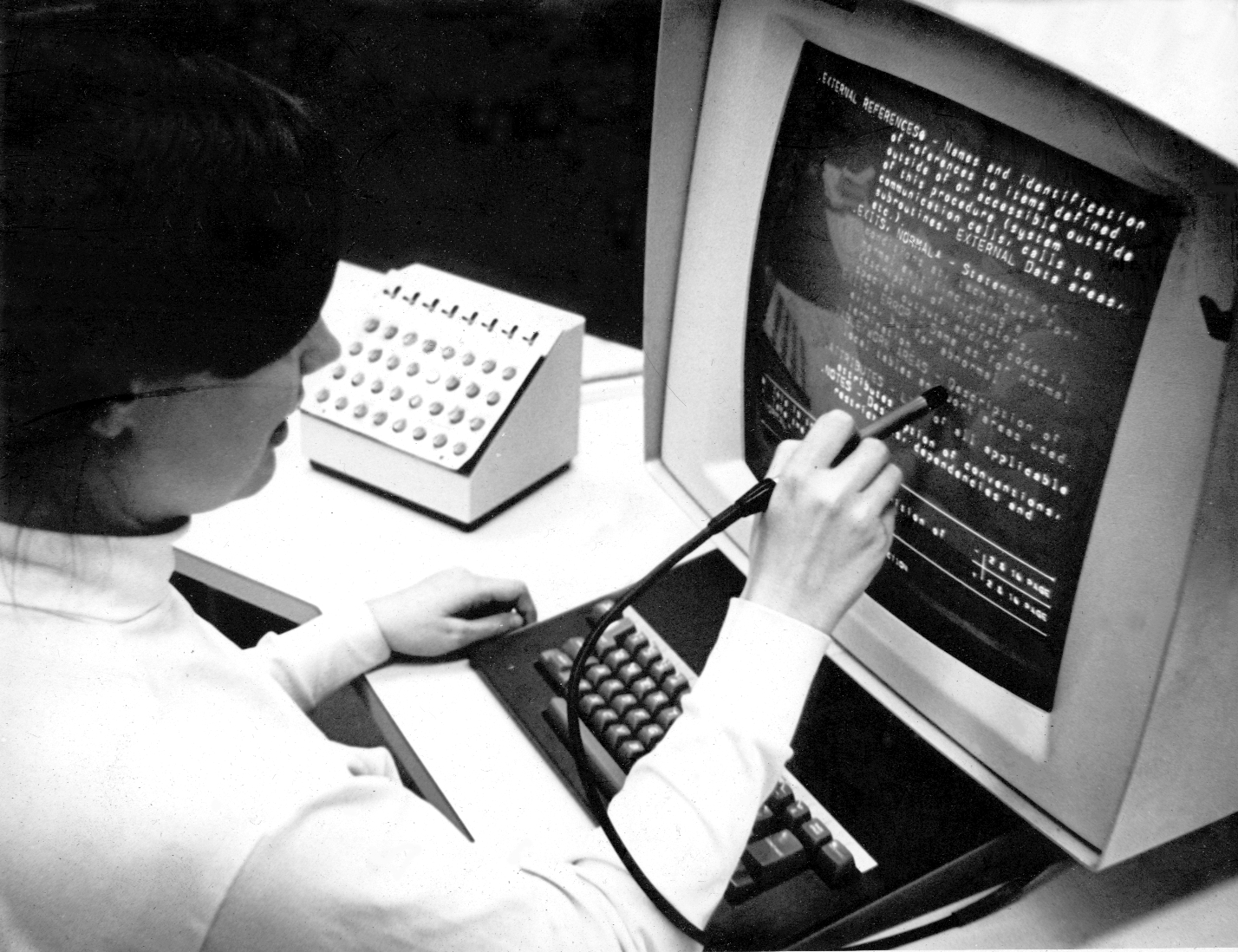|
Thomson EF9366
The Thomson EF936x series is a type of Graphic Display Processor (GDP) by Thomson-EFCIS. The chip could draw at 1 million pixels per second, which was relatively advanced for the time of its release (1982 or earlier). There are various versions of the chip (EF9364, EF9365, EF9366, EF9367, SFF96364, EF9369), with slightly different capabilities. In 1982 Commodore released a "High Resolution Graphics" board for the PET based on the EF9365 and EF9366 chips, allowing it to display 512 x 512 or 512 x 256 resolution graphics. The EF9366 was also used on the SMP-E353 graphic card for the Siemens computer series and on the NDR-Klein-Computer introduced in 1984. Version EF9369 was used on computers such as the Thomson MO5NR, Thomson MO6, Thomson TO8, Thomson TO9 and Thomson TO9+, from 1985 to 1989. Versions Based on the 1989 data book published by the company, the EF936x series was split into ''Graphics Controllers'' and ''Color Palette'' models. Graphics Controllers *EF9364 CRT Pr ... [...More Info...] [...Related Items...] OR: [Wikipedia] [Google] [Baidu] |
NDR Klein Computer GDP64 Karte
NDR may refer to: Computing * Non delivery report, a return email message to a sender indicating failed message delivery * Network Data Representation, an implementation of the OSI model presentation layer Science and technology * Negative differential resistance * Naming and Design Rules in metadata * Neighborhood deformation retract, a kind of topological subspace * National Data Repository, a system to store data about a nation's natural resources Others * Nador International Airport (IATA code name: NDR), airport in Morocco * National Driver Register, United States * Norddeutscher Rundfunk, a public radio and television broadcaster in northern Germany * Norwich Northern Distributor Road or Broadland Northway, a major route around the north of Norwich, England * Singapore National Day Rally, an annual address that the Prime Minister of Singapore makes to the nation * Non-invasive disc rehabilitation, NDR Method * Nash Dom Rossiya (Наш Дом Россия, Our Home Is Rus ... [...More Info...] [...Related Items...] OR: [Wikipedia] [Google] [Baidu] |
Thomson TO9+
The Thomson TO9+ is a home computer introduced by French company Thomson SA in 1986. It kept the professional look of the Thomson TO9 by using a separate keyboard (lower end models usually had an integrated keyboard). It's based on the Thomson TO8 and fully compatible with it. This also enables it to run Thomson MO6 software. The computer was designed to be used as a Minitel server and has a built-in V23 modem (with a speed of 1200/75 bauds). This feature was accessible under BASIC BASIC (Beginners' All-purpose Symbolic Instruction Code) is a family of general-purpose, high-level programming languages designed for ease of use. The original version was created by John G. Kemeny and Thomas E. Kurtz at Dartmouth College ... and from the communication software that came with the computer. The machine was sold with a word processing program (''Paragraphe''), a database (''Fiches & Dossiers'') and a spreadsheet (''Multiplan''). Compared with the TO9, the TO9+ added: * Basi ... [...More Info...] [...Related Items...] OR: [Wikipedia] [Google] [Baidu] |
List Of Home Computers By Video Hardware
This is a list of home computers, sorted alphanumerically, which lists all relevant details of their video hardware. Home computers are the second generation of desktop computers, entering the market in 1977 and becoming common during the 1980s. A decade later they were generally replaced by IBM PC compatible "PCs", although technically home computers are also classified as personal computers. Examples of typical early home computers are the TRS-80, Atari 400/800, BBC Micro, the ZX Spectrum, the MSX 1, the Amstrad CPC 464 and the Commodore 64. Examples of typical late home computers are MSX 2 systems, and the Amiga and Atari ST systems. Note: in cases of manufacturers who have made both home and personal computers, only machines fitting into the ''home'' computer category are listed. Systems in the personal computer category, except for Early Macintosh PCs, are generally based on the VGA standard and use a video chip known as a Graphics Processing Unit. Very early PCs used on ... [...More Info...] [...Related Items...] OR: [Wikipedia] [Google] [Baidu] |
Thomson EF934x
The EF9345 from SGS-Thomson Microelectronics, Inc., was a semigraphic microprocessor for video image control, encapsulated in a 40-pin DIP and used primarily in the Matra Alice 32, Matra Alice 90 and Philips VG5000 microcomputers. The EF9345 was capable of displaying 8 colors ( RGB primaries), 128 alphanumeric characters and 128 semigraphic characters. It had one semigraphic mode and 40- and 80-column text modes. It was able to address up to 16KB of dedicated video RAM. Video Modes * 50/60Hz output ** Interlaced or progressive scan *Semigraphics: ** 128 standard character set with 5x7 pixel font dimensions. User definable 8x10 pixel alphanumeric or semigraphic sets. *40 characters x 25 rows text mode (similar to teletext): ** 8 x 10 pixel font ** Selectable background and foreground colors ** Styles: double height, double width, blinking, reverse, underline, conceal, insert, accentuation of lowercase characters *80 characters x 25 rows text mode: ** 6 x 10 pixel font ** Styles: ... [...More Info...] [...Related Items...] OR: [Wikipedia] [Google] [Baidu] |
Computer Memory
In computing, memory is a device or system that is used to store information for immediate use in a computer or related computer hardware and digital electronic devices. The term ''memory'' is often synonymous with the term ''primary storage'' or '' main memory''. An archaic synonym for memory is store. Computer memory operates at a high speed compared to storage that is slower but less expensive and higher in capacity. Besides storing opened programs, computer memory serves as disk cache and write buffer to improve both reading and writing performance. Operating systems borrow RAM capacity for caching so long as not needed by running software. If needed, contents of the computer memory can be transferred to storage; a common way of doing this is through a memory management technique called ''virtual memory''. Modern memory is implemented as semiconductor memory, where data is stored within memory cells built from MOS transistors and other components on an integrated c ... [...More Info...] [...Related Items...] OR: [Wikipedia] [Google] [Baidu] |
Light Pen
A light pen is a computer input device in the form of a light-sensitive wand used in conjunction with a computer's cathode-ray tube (CRT) display. It allows the user to point to displayed objects or draw on the screen in a similar way to a touchscreen but with greater positional accuracy. A light pen can work with any CRT-based display, but its ability to be used with LCDs was unclear (though Toshiba and Hitachi displayed a similar idea at the "Display 2006" show in Japan). A light pen detects changes in brightness of nearby screen pixels when scanned by cathode-ray tube electron beam and communicates the timing of this event to the computer. Since a CRT scans the entire screen one pixel at a time, the computer can keep track of the expected time of scanning various locations on screen by the beam and infer the pen's position from the latest time stamps. History The first light pen, at this time still called "light gun", was created around 1945–1955 as part of the Whirl ... [...More Info...] [...Related Items...] OR: [Wikipedia] [Google] [Baidu] |
Supersample Anti-aliasing
Supersampling or supersampling anti-aliasing (SSAA) is a spatial anti-aliasing method, i.e. a method used to remove aliasing (jagged and pixelated edges, colloquially known as "jaggies") from images Rendering (computer graphics), rendered in computer games or other computer programs that generate imagery. Aliasing occurs because unlike real-world objects, which have continuous smooth curves and lines, a computer screen shows the viewer a large number of small squares. These pixels all have the same size, and each one has a single color. A line can only be shown as a collection of pixels, and therefore appears jagged unless it is perfectly horizontal or vertical. The aim of supersampling is to reduce this effect. Color samples are taken at several instances inside the pixel (not just at the center as normal), and an average color value is calculated. This is achieved by rendering the image at a much higher Display resolution, resolution than the one being displayed, then shrinkin ... [...More Info...] [...Related Items...] OR: [Wikipedia] [Google] [Baidu] |
ASCII
ASCII ( ), abbreviated from American Standard Code for Information Interchange, is a character encoding standard for electronic communication. ASCII codes represent text in computers, telecommunications equipment, and other devices. Because of technical limitations of computer systems at the time it was invented, ASCII has just 128 code points, of which only 95 are , which severely limited its scope. All modern computer systems instead use Unicode, which has millions of code points, but the first 128 of these are the same as the ASCII set. The Internet Assigned Numbers Authority (IANA) prefers the name US-ASCII for this character encoding. ASCII is one of the List of IEEE milestones, IEEE milestones. Overview ASCII was developed from telegraph code. Its first commercial use was as a seven-bit teleprinter code promoted by Bell data services. Work on the ASCII standard began in May 1961, with the first meeting of the American Standards Association's (ASA) (now the American Nat ... [...More Info...] [...Related Items...] OR: [Wikipedia] [Google] [Baidu] |
DRAM
Dynamic random-access memory (dynamic RAM or DRAM) is a type of random-access semiconductor memory that stores each bit of data in a memory cell, usually consisting of a tiny capacitor and a transistor, both typically based on metal-oxide-semiconductor (MOS) technology. While most DRAM memory cell designs use a capacitor and transistor, some only use two transistors. In the designs where a capacitor is used, the capacitor can either be charged or discharged; these two states are taken to represent the two values of a bit, conventionally called 0 and 1. The electric charge on the capacitors gradually leaks away; without intervention the data on the capacitor would soon be lost. To prevent this, DRAM requires an external ''memory refresh'' circuit which periodically rewrites the data in the capacitors, restoring them to their original charge. This refresh process is the defining characteristic of dynamic random-access memory, in contrast to static random-access memory (SRA ... [...More Info...] [...Related Items...] OR: [Wikipedia] [Google] [Baidu] |
Gamma
Gamma (uppercase , lowercase ; ''gámma'') is the third letter of the Greek alphabet. In the system of Greek numerals it has a value of 3. In Ancient Greek, the letter gamma represented a voiced velar stop . In Modern Greek, this letter represents either a voiced velar fricative or a voiced palatal fricative (while /g/ in foreign words is instead commonly transcribed as γκ). In the International Phonetic Alphabet and other modern Latin-alphabet based phonetic notations, it represents the voiced velar fricative. History The Greek letter Gamma Γ is a grapheme derived from the Phoenician letter (''gīml'') which was rotated from the right-to-left script of Canaanite to accommodate the Greek language's writing system of left-to-right. The Canaanite grapheme represented the /g/ phoneme in the Canaanite language, and as such is cognate with ''gimel'' ג of the Hebrew alphabet. Based on its name, the letter has been interpreted as an abstract representation of a camel's ... [...More Info...] [...Related Items...] OR: [Wikipedia] [Google] [Baidu] |
List Of Monochrome And RGB Color Formats
This list of monochrome and RGB palettes includes generic repertoires of colors ( color palettes) to produce black-and-white and RGB color pictures by a computer's display hardware. RGB is the most common method to produce colors for displays; so these complete RGB color repertoires have every possible combination of R-G-B triplets within any given maximum number of levels per component. Each palette is represented by a series of color patches. When the number of colors is low, a 1-pixel-size version of the palette appears below it, for easily comparing relative palette sizes. Huge palettes are given directly in one-color-per-pixel color patches. For each unique palette, an image color test chart and sample image ( truecolor original follows) rendered with that palette (without dithering) are given. The test chart shows the full 256 levels of the red, green, and blue (RGB) primary colors and cyan, magenta, and yellow complementary colors, along with a full 256-level grayscale. G ... [...More Info...] [...Related Items...] OR: [Wikipedia] [Google] [Baidu] |
SECAM
SECAM, also written SÉCAM (, ''Séquentiel de couleur à mémoire'', French for ''color sequential with memory''), is an analog color television system that was used in France, some parts of Europe and Africa, and Russia. It was one of three major analog color television standards, the others being PAL and NTSC. This page primarily discusses the SECAM colour encoding system. The articles on broadcast television systems and analog television further describe frame rates, image resolution, and audio modulation. SECAM video is composite video because the luminance (luma, monochrome image) and chrominance (chroma, color applied to the monochrome image) are transmitted together as one signal. All the countries using SECAM are currently in the process of conversion, or have already converted to Digital Video Broadcasting (DVB), the new pan-European standard for digital television. SECAM remained a major standard into the 2000s. History Development of SECAM predates PAL, and be ... [...More Info...] [...Related Items...] OR: [Wikipedia] [Google] [Baidu] |


.jpg)




